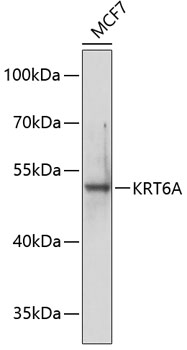Anti-KRT6A Antibody (CAB7560)
- SKU:
- CAB7560
- Product type:
- Antibody
- Reactivity:
- Human
- Host Species:
- Rabbit
- Isotype:
- IgG
- Antibody Type:
- Polyclonal Antibody
- Research Area:
- Cell Biology
Frequently bought together:
Description
| Antibody Name: | Anti-KRT6A Antibody |
| Antibody SKU: | CAB7560 |
| Antibody Size: | 20uL, 50uL, 100uL |
| Application: | WB |
| Reactivity: | Human |
| Host Species: | Rabbit |
| Immunogen: | Recombinant fusion protein containing a sequence corresponding to amino acids 305-564 of human KRT6A (NP_005545.1). |
| Application: | WB |
| Recommended Dilution: | WB 1:500 - 1:2000 |
| Reactivity: | Human |
| Positive Samples: | MCF7 |
| Immunogen: | Recombinant fusion protein containing a sequence corresponding to amino acids 305-564 of human KRT6A (NP_005545.1). |
| Purification Method: | Affinity purification |
| Storage Buffer: | Store at -20°C. Avoid freeze / thaw cycles. Buffer: PBS with 0.02% sodium azide, 50% glycerol, pH7.3. |
| Isotype: | IgG |
| Sequence: | ELSQ MQTH ISDT SVVL SMDN NRNL DLDS IIAE VKAQ YEEI AQRS RAEA ESWY QTKY EELQ VTAG RHGD DLRN TKQE IAEI NRMI QRLR SEID HVKK QCAN LQAA IADA EQRG EMAL KDAK NKLE GLED ALQK AKQD LARL LKEY QELM NVKL ALDV EIAT YRKL LEGE ECRL NGEG VGQV NISV VQST VSSG YGGA SGVG SGLG LGGG SSYS YGSG LGVG GGFS SSSG RAIG GGLS SVGG GSST IKYT TTSS SSRK SYKH |
| Gene ID: | 3853 |
| Uniprot: | P02538 |
| Cellular Location: | |
| Calculated MW: | 60kDa |
| Observed MW: | 50kDa |
| Synonyms: | KRT6A, CK-6C, CK-6E, CK6A, CK6C, CK6D, K6A, K6C, K6D, KRT6C, KRT6D, PC3 |
| Background: | The protein encoded by this gene is a member of the keratin gene family. The type II cytokeratins consist of basic or neutral proteins which are arranged in pairs of heterotypic keratin chains coexpressed during differentiation of simple and stratified epithelial tissues. As many as six of this type II cytokeratin (KRT6) have been identified; the multiplicity of the genes is attributed to successive gene duplication events. The genes are expressed with family members KRT16 and/or KRT17 in the filiform papillae of the tongue, the stratified epithelial lining of oral mucosa and esophagus, the outer root sheath of hair follicles, and the glandular epithelia. This KRT6 gene in particular encodes the most abundant isoform. Mutations in these genes have been associated with pachyonychia congenita. In addition, peptides from the C-terminal region of the protein have antimicrobial activity against bacterial pathogens. The type II cytokeratins are clustered in a region of chromosome 12q12-q13. |
| UniProt Protein Function: | K6a: a type II cytoskeletal keratin. The keratins are intermediate filament proteins responsible for the structural integrity of epithelial cells and are subdivided into cytokeratins and hair keratins. There are two types of cytoskeletal and microfibrillar keratin: type I (acidic; 40-55 kDa) [K9 to K20] and type II (neutral to basic; 56-70 kDa) [K1 to K8]. Both a basic and an acidic keratin are required for filament assembly. Associates with K16 and/or -17. |
| UniProt Protein Details: | Protein type:Cytoskeletal Chromosomal Location of Human Ortholog: 12q13.13 Cellular Component: membrane; keratin filament; nucleus Molecular Function:protein binding; structural constituent of cytoskeleton Biological Process: wound healing; positive regulation of cell proliferation; morphogenesis of an epithelium; cell differentiation Disease: Pachyonychia Congenita 3 |
| NCBI Summary: | The protein encoded by this gene is a member of the keratin gene family. The type II cytokeratins consist of basic or neutral proteins which are arranged in pairs of heterotypic keratin chains coexpressed during differentiation of simple and stratified epithelial tissues. As many as six of this type II cytokeratin (KRT6) have been identified; the multiplicity of the genes is attributed to successive gene duplication events. The genes are expressed with family members KRT16 and/or KRT17 in the filiform papillae of the tongue, the stratified epithelial lining of oral mucosa and esophagus, the outer root sheath of hair follicles, and the glandular epithelia. This KRT6 gene in particular encodes the most abundant isoform. Mutations in these genes have been associated with pachyonychia congenita. In addition, peptides from the C-terminal region of the protein have antimicrobial activity against bacterial pathogens. The type II cytokeratins are clustered in a region of chromosome 12q12-q13. [provided by RefSeq, Oct 2014] |
| UniProt Code: | P02538 |
| NCBI GenInfo Identifier: | 1346344 |
| NCBI Gene ID: | 3853 |
| NCBI Accession: | P02538.3 |
| UniProt Related Accession: | P02538 |
| Molecular Weight: | 60kDa |
| NCBI Full Name: | Keratin, type II cytoskeletal 6A |
| NCBI Synonym Full Names: | keratin 6A |
| NCBI Official Symbol: | KRT6A |
| NCBI Official Synonym Symbols: | K6A; K6C; K6D; PC3; CK6A; CK6C; CK6D; CK-6C; CK-6E; KRT6C; KRT6D |
| NCBI Protein Information: | keratin, type II cytoskeletal 6A |
| UniProt Protein Name: | Keratin, type II cytoskeletal 6A |
| UniProt Synonym Protein Names: | Cytokeratin-6A; CK-6A; Cytokeratin-6D; CK-6D; Keratin-6A; K6A; Type-II keratin Kb6; Allergen: Hom s 5 |
| UniProt Gene Name: | KRT6A |
| UniProt Entry Name: | K2C6A_HUMAN |




